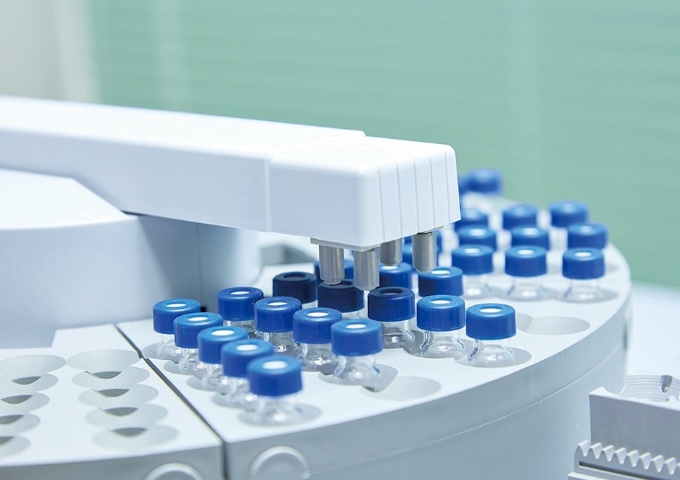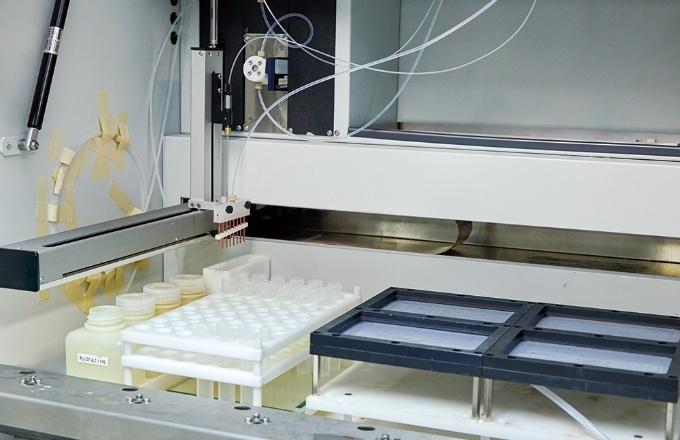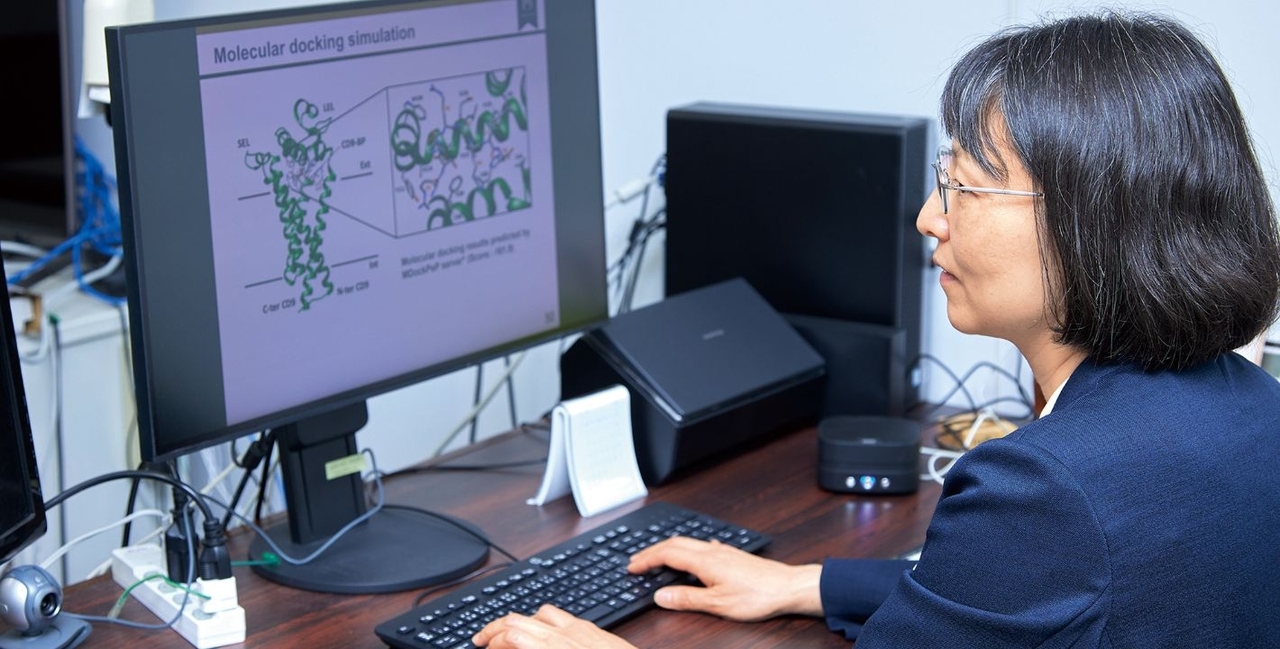
Technology that creates the world
Peptides possess a wide variety of physiological activities[1]. In peptide biosensors, researchers try to design and synthesize peptides with specific functions, and then use those peptides as probes of sensors. This application is being actively studied all over the world in recognition of its high sensitivity and specificity. Professor Mina Okochi has been working on screening of various functional peptides which can be applied for biosensors.
Welcome to a world of biotechnology and biosensors in which desired functions are derived from a myriad of possibilities.
Searching for peptides with desired functions and using them as biosensors
A biosensor is a chemical sensor that enables the detection and quantification of specific molecules by using biomolecular interactions and biological reactions as elements for identification. Biosensors can measure or monitor specific molecules and activities. They have been gradually developed since the 1960s. Furthermore, technology using peptides for identification began to attract attention from around the 1990s. Peptides can be used as probes for identifying various targets based on their amino acid sequences. In this way, peptides have greatly expanded the range of applications for biosensors.
I have been doing research on the search for functional peptides since 2004. When screening of a specific sequence to give a desired function to a peptide, it is necessary to search from a vast combination of amino acid bonds. Therefore, in order to efficiently conduct trials, I use a method called peptide array. This method consists of solid-phase synthesis[2] that systematically combines a large number of peptides. Even after discovering a target sequence, I conduct repeated verifications and consider the appropriate design for using the sequence as an identification probes. This series of steps is known as a "peptide screening." In recent years, I have been particularly focused on the search for functional peptides capable of detecting odor molecules, as well as the application of those peptides to develop odor sensors. In February 2023, in collaboration with a professor of materials science, I succeeded in developing a highly sensitive graphene odor sensor using peptides. The sensor can be used to detect volatile organic compounds which are the source of odors. In this research, I am mainly designing a probe that detects limonene, the smell of lemon; that is, a peptide used as a substance for detecting a specific target.
A big step toward realizing a "bioelectronic nose"
"Living organisms are composed of multiple combinations of functions and mechanisms that recognize molecules.This research field is worth exploring to unravel its endless mechanisms and discover new possibilities for applications."
In 1998, completed her doctorate at the Graduate School of Engineering, Tokyo University of Agriculture and Technology. In 1999, appointed as Research Associate at the Department of Biotechnology and Life Science in the Faculty of Engineering, Tokyo University of Agriculture and Technology. In 2004, appointed as Lecturer at the Department of Applied Chemistry, Chemical Engineering and Biotechnology in the Graduate School of Engineering, Nagoya University. In 2008, promoted to Associate Professor at the same department. Assumed her current position in 2014. Doctor of Biotechnology (Tokyo University of Agriculture and Technology). Specializes in peptide engineering. In 2021, received the 30th Technical Award of the Society for Biotechnology, Japan.
Odor sensors using peptides have potential applications in a wide range of fields, including healthcare, environmental monitoring, food, and cosmetics. Many attempts have been made to develop a bioelectronic nose that electrically detects odors by using olfactory receptors[3] of mammals into biosensors. However, the difficulty of creating/arranging receptors and the low stability are barriers. However, peptides can be synthesized using any amino acid sequence and are relatively stable. This will make it possible to develop sensors that can respond to various odor molecules.
Since obtaining my Ph.D., I have been working as a researcher for more than 20 years. When I was a student, I conducted research in a different area within bioelectronics. One reason why I started to study biotechnology was the Human Genome Project that had been in progress around the world when I was a university student. Around the time I finished graduate school, I received an announcement that major advancements had been made in genome analysis. My heart raced at the prospect of major changes in biological research. Regardless of what path one takes, there are always new developments in research. By remaining true to my interests, I will pursue sensing that pushes the limits of current technology.
Relationship among peptides, proteins, and amino acids
Together with carbohydrates and fats, proteins are known as one of the three major nutrients. Proteins are also the material for our skin, hair, nails, internal organs, and muscles. Composed of more than 50 amino acids, proteins are an essential substance for human life. However, protein molecules in their normal state are too large to be assimilated by the human body. Therefore, proteins are digested to amino acids or peptides, which consist of two or more amino acids linked in a chain using digestive enzymes.
Peptides are diverse in form and function
There are 20 types of amino acids that compose human proteins and peptides. However, peptides have a huge number of sequences. Peptides are extremely diverse; combining two amino acids will result in 400 types (20 x 20), while combining three amino acids will result in 8,000 types (20 x 20 x 20). Peptides fulfill numerous functions in life activities. The functions known at present are truly rich in variety. For example, peptides are well known for functions such as protecting the body from bacteria, lowering blood pressure, controlling blood sugar, suppressing inflammatory reactions, and protecting cells from oxidative stress. Peptides are already widely used in fields such as the development of drugs and cosmetics.
Using peptides as nanomaterials in engineering
By utilizing their functionality and small size, peptides can be applied to engineering. For example, by converting the peptide binding to a specific molecule into a signal that can be handled by a machine, we can create a sensor for measuring the presence and quantity of molecules that we want to detect but are not visible to the human eye. Peptides also have a wide range of other engineering applications. Examples include aiding in nanoparticle synthesis by controlling the shape and size of nanoparticles, helping drugs reach target tissues through the use of cell-penetrating peptides, and using peptides as a component of biomaterials that are widely utilized in the medical and dental fields.
Each biological reaction consists of intricate chemical reactions carried out by proteins at the molecular level. Peptides are the key to artificially controlling these reactions.
A biosensor is a chemical sensor that utilizes the exceptional molecular recognition ability of living organisms to acquire quantitative information on a specific molecule. A biosensor consists of three main components. The first component is the bioreceptor, a biological element that recognizes the target molecule. The second is the transducer, which converts the signal recognized by the element into a measurable signal, such as light or electricity. The third is the amplifier, which processes, appropriately amplifies, and digitizes the signal converted by a transducer. Many scientists and researchers have been involved in the development of biosensors for a long time. However, the glucose enzyme electrode invented by American scientist Leland C. Clark in 1962 is considered to be the beginning of biosensors. Since then, many biosensors have been produced up to the present day using materials such as proteins, DNA, microorganisms, cells, and tissues as bioreceptors.
It is said that peptides began to be used as recognition receptor molecules around the 1990s. The high specificity of peptides makes them superior receptors. Peptides are molecules that can act with pinpoint accuracy on specific proteins or molecules by binding amino acids, thereby enabling accurate detection and recognition of targets. Unlike proteins, which are composed of tens to thousands of amino acids and have complex structures that are difficult to synthesize artificially, peptides have simple structures, can be synthesized relatively easily, and are stable. By taking advantage of these properties and conducting repeated trials, researchers are screening functional peptides that can specifically bind to the molecule to be detected and serve as a receptor. In this way, the history of biosensor development using peptides is closely related to the advancements in peptide screening.
The challenge of quantitatively detecting odors
In order to constantly explore new possibilities for biosensing, Okochi has been searching for many types of functional peptides using peptide arrays. In particular, her latest research is on the design of functional peptides that detect and identify limonene, a plant-derived odor molecule.
In the past, various countries have worked to develop "bioelectronic noses" that imitate the odor sensing mechanism of mammals and use olfactory receptors as receptors. Unfortunately, several issues have hindered the practical implementation of these research initiatives. Specifically, the acquisition route of olfactory receptors has been an issue. Olfactory receptors are generally biosynthesized through the involvement of living organisms and enzymes. This biosynthesis requires specialized skills and equipment, which requires a large amount of funds. Of course, the number of receptors that can be created is limited due to biosynthesis. Furthermore, even if a receptor functions in vivo, there is also the problem of the receptor losing its function and stability as the sensing probes. Peptides are an alternative substance that can compensate for these weaknesses. Until recently, the development of odor sensors using peptides had not progressed significantly, even on a global scale. However, in 2023, a research team led by Okochi announced a graphene odor sensor that utilizes peptides with an additional amino acid sequence interacting with specific odor molecules. Using such peptides, the team succeeded in high-sensitivity detection of odor molecules, which are difficult to detect. Additionally, by performing a principal component analysis of the electrical response of the sensor, the team achieved differentiation of dissimilar odors from complex odor information.
"I took on the challenge of searching for functional peptides with the theme of odor because I believed that chemical sensors could fulfill the role of detection dogs used in animal and plant quarantine operations at airports," explains Okochi. "Prior to focusing on the smell of limonene, I was working on sensing to detect the explosive TNT (trinitrotoluene). Practical use of biosensors will make it possible to observe odors objectively, which is difficult when conducting qualitative detection by humans and animals. In the future, if we can use this research to develop new sensors that are comparable to the olfactory sense of living organisms, the scope of application will expand sequentially. For example, in addition to detecting foreign objects, it will become possible to detect diseases, monitor environmental conditions, and control product quality."


A gas chromatograph mass spectrometer, which is also used to analyze the components contained in odorants
Mechanism of odor molecule detection observed on the surface of graphene
A biosensor requires a mechanism that converts a specific reaction into a change in electric current and then captures that change as a signal. In the case of the graphene odor sensor jointly announced with the research team led by Associate Professor Yuhei Hayamizu in 2023, the change in peptide structure caused by the binding of volatile organic compounds, which are odor molecules, to the peptide on graphene, which is a two-dimensional carbon material, is measured as a signal.

* Hayamizu conducts research on self-assembling peptides for a graphene odor sensor.
Use in allergy treatment
Peptide analysis using peptide arrays is not limited to use as a biosensor. It is also useful as a technology that supports testing and treatment of people suffering from food allergies. In 2021, Okochi and her collaborators were awarded the Technology Award of the Society for Biotechnology, Japan in recognition of research on low-antigenic bioactive peptides for milk allergy.
"In food allergies, the immune system overreacts to specific proteins (antigens) contained in food, thus causing allergic symptoms," explains Okochi. "Currently, milk peptides, which are highly enzymatically digested milk proteins, are used throughout the world for the treatment of milk allergy. Since various peptide sequences are mixed in milk peptides, in order to improve the accuracy of suppressing allergic reactions, we cooperated with food companies to identify the sequences of antigenic peptides and develop technology for highly sensitive detection and quantification."
Okochi Laboratory is exploring the multifaceted functionality of peptides, envisioning applications as they search for the desired peptides. Students in the laboratory are also passionate about this research that has endless potential–potential made possible by functional peptides.
Peptide synthesizer
A peptide synthesizer automatically synthesizes peptides by combining different amino acids in order. These synthesizers are indispensable for making peptide arrays and improving the efficiency of peptide screenings. The peptide synthesizer which belongs to Okochi Laboratory can synthesize 2,400 types of peptides in an array at once, a process that takes about three to four days.

Inside the peptide synthesizer

Terms
[1]
Physiological activities : The actions exerted by chemical substances in the living organism on specific physiological regulation functions of the organism.
[2]
Solid-phase synthesis : A method of synthesizing peptides and proteins in which a molecule is immobilized on a solid support and chemically reacted with reagents on the support.
[3]
Receptors : Molecules that receive and transmit various external signals. Olfactory receptors have the property of binding to odor molecules in the environment.
Published: September 2023
. Any information published on this site will be valid in relation to Science Tokyo.










